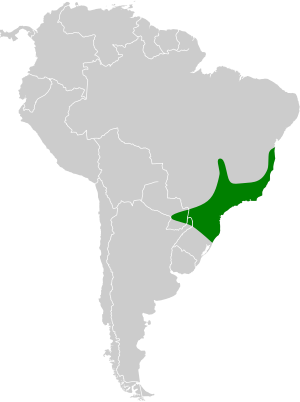Southern little yellow-eared bat facts for kids
Quick facts for kids Southern little yellow-eared bat |
|
|---|---|
 |
|
| Conservation status | |
| Scientific classification | |
| Genus: |
Vampyressa
|
| Species: |
pusilla
|
 |
|
The southern little yellow-eared bat (Vampyressa pusilla) is a small bat that loves to eat fruit. You can find this interesting creature in parts of South America, including Brazil, Argentina, and Paraguay. It's a fascinating animal that plays a role in its ecosystem.
Contents
Meet the Southern Little Yellow-Eared Bat
The southern little yellow-eared bat is a type of bat known for its small size. It belongs to a group of bats called Vampyressa. These bats are not scary vampires. Instead, they are peaceful fruit-eaters! They help spread seeds in the forests where they live. This helps new plants grow.
What Does It Look Like?
This bat is quite tiny, as its name suggests. It has a body length of about 4 to 5 centimeters (around 2 inches). Its fur is usually a brownish-gray color. The "yellow-eared" part of its name comes from the yellowish edges on its ears. It also has a small, leaf-shaped nose. This nose leaf helps it with echolocation. Echolocation is like a natural sonar system. It helps bats find their way in the dark.
Where Does It Live?
The southern little yellow-eared bat lives in tropical and subtropical forests. These forests are found in South America. It prefers areas with lots of trees. These trees provide both food and shelter. They can be found in lowlands and sometimes in higher areas. Their habitat includes dense forests and even some disturbed areas.
What Does It Eat?
This bat is a frugivore. This means its main diet is fruit! They love to munch on different kinds of berries and fruits. By eating fruit, they also help the forest. When they fly, they drop seeds from the fruits they eat. This process is called seed dispersal. It helps new plants grow in different places. This makes the forest healthier.
Life Cycle and Reproduction
Like all mammals, southern little yellow-eared bats give birth to live young. Bat mothers usually have one baby at a time. The baby bat is called a pup. Pups are born tiny and helpless. They rely on their mother's milk for food. The mother bat cares for her pup in a safe roost. Roosts are places where bats rest. These can be in trees or other sheltered spots. As the pup grows, it learns to fly and find its own food.
Why Are Bats Important?
Bats like the southern little yellow-eared bat are very important for the environment.
- They help pollinate plants. This means they help plants make seeds.
- They spread seeds, helping forests grow.
- They can also help control insect populations.
These roles make bats a vital part of their ecosystems. Protecting bats helps protect the health of our planet.
See also
 In Spanish: Vampyressa pusilla para niños
In Spanish: Vampyressa pusilla para niños


